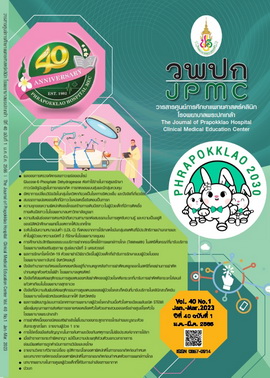Effects of Nursing Supervision System Development for Patients with ST-Segment Elevation Myocardial Infarction (STEMI) to Increase the Quality of Primary Percutaneous Coronary Intervention Received at Phrapokklao Hospital
Main Article Content
Abstract
BACKGROUND: The Heart Center at Phrapokklao Hospital had a higher mortality rate among STEMI patients than the target. Thus, the development of nursing supervision to increase the capacity of personnel in network hospitals so that patients could be transferred efficiently for primary percutaneous coronary intervention (PPCI) during the golden period was necessary.
OBJECTIVES: This study aimed to develop a nursing supervision model for STEMI patients to increase referral quality for standardized PPCI procedures and to evaluate the effect of the model.
METHODS: The study used a research and development design with a target population consisting of 19 network coordinator nurses from 16 hospitals in the heart center network, Phrapokklao Hospitals and 40 patients diagnosed with STEMI sent for PPCI from October to December 2022. The research process consisted of a situational analysis of the STEMI patient care problems at the heart center, development of the temporary nursing supervision model, and supervision to encourage network coordinator nurses to comply with standards using the developed guidelines. The model was tried and tested, with follow up on the supervision and evaluation of performance. The model was then updated and monitored for results. The Satisfaction Assessment Form for the Supervision Model, and the Standard Compliance Assessment Form showed reliability of 0.95 and 0.87, respectively. Information was recorded for STEMI patients and the first medical contact to device time. Data were analyzed using descriptive statistics, Independent t-test, Chi-square test, and content analysis.
RESULTS: The developed nursing supervision model was based on formative supervision principles and normative supervision standards using the principles of restorative clinical supervision and participation. A handbook of STEMI patient care for PPCI submission consistency, flow chart manuals, and real-time forwarding records were provided. Zoom technology and line groups were set up to communicate information, solve problems, and supervise the practice of referral coordinator nurses in network hospitals. The results showed suitable standard compliance among nurse coordinators from the network hospitals (94.7%), the good satisfaction with the supervision method (M=3.7±0.3). The target population consisted of 40 STEMI patients; the majority were males (82.5%). After the model development, the referral time for STEMI patients from network hospitals for PPCI was significantly lower than before the model development (M=95.6±29.6 vs M=135.4±62.4, p<0.001), and the number of patients referred for PPCI within 120 minutes was significantly higher than before development (82.5% vs 50.4%, p<0.001).
CONCLUSIONS: The developed model could be used as a guideline to increase referral efficiency from network hospitals, thus enabling STEMI patients to receive more standardized PPCI and reduce patient mortality.
Article Details

This work is licensed under a Creative Commons Attribution-NonCommercial-NoDerivatives 4.0 International License.
References
Cardiac Care Network. Recommendations for best-practicestemi management in Ontario [Internet]. 2013 [cited 2022 Aug 22]. Available from:https://www.corhealthontario.ca/Recommendations-for-Best-Practice-STEMI-Management-in-Ontario-(6).pdf
The Heart Association of Thailand under the Royal Patronage of H.M. the King. Thai acute coronary syndromes guidelines 2020. Bangkok: Nextstep Design Co., Ltd; 2020.
Huber K, Goldstein P, Danchin N, Fox KA, Welsh R, Granger CB, et al. Enhancing the efficacy of delivering reperfusion therapy: a European and North American experience with ST-segment elevation myocardial infarction networks. Am Heart J 2013;165:123-32.
Kristensen SD, Laut KG, Fajadet J, Kaifoszova Z, Kala P, Di Mario C, et al. Reperfusion therapy for ST elevation acute myocardial infarction 2010/2011: current status in 37 ESC countries. Eur Heart J 2014;35:1957-70.
The Heart Association of Thailand under the Royal Patronage of H.M. the King, National Health Security Office. Percutaneous coronary intervention, PCI [Internet].[cited 2019 Jun 10]. Available from: http://www.thaiheart.org/images/column_1291454908/PCIGuideline.pdf
Phrapokklao Hospital. Statistics of STEMI patients in2020-2022 referred from network hospitals for PPCI at the heart center, Phrapokklao hospital. Chanthaburi: Data center at Heart Center; 2022.
The Healthcare Accreditation Institute. Hospital and healthcare standards. 4th ed. Nonthaburi: Healthcare Accreditation Institute; 2018.
Tangwongkit T, Kerdmuang S, Chaiyasak M,WeerawatthanodomN,Pungpotong S. Effects of participatory nursing supervision program on the quality ofsupervision of head nurses in general hospital, Chainatprovince. NJPH. 2020;30(2):190-202.
Wanthanatas R, Sritragool R, DaphaS, Changming A, Learahabumrung P, Naklamai A. Development of a nursing clinical supervision model for high alert drugs (HADs) administration with nurse supervi-sors’ participation in NakhonPathom hospital. Journal of Nursing and Health Care 2018;36(1):234-43.
Kamnoetkiattisak S, Anusanti S, Sirilukkhananun K. The effect of using the nursing supervision model integrated with critical thinkingconception perceived reasoning ability in nursingpractice of professional nurse. Vajira Nursing Journal 2019;21(1):18–33.
Sangmanee W, Kaewvichit N, Thongsuk P, Thiangchanya P, BoonyoungN, KulkueaN. The development of nursing supervision program model for the first-linemanager based on 2P safety: SIMPLE (medication error, fall)at a tertiary care hospital in Southern Thailand. Princess of Naradhiwas University Journal, 2022;14(1):1-16.
Chuang S, Inder K. An effectiveness analysis of healthcare systems using a systems theoretic approach. BMC Health Services Research [Internet]. 2009 [cited 2022 Jan 17];9:195. Available from: http://www.biomedcentral.com/1472-6963/9/195
Proctor B. Training for the supervision alliance attitude, skills and intention. In: Cutcliffe JR, Hyrkas K, Fowler J, editors. Routledge handbook of clinical supervision: fundamental international themes. Oxfordshire: Routledge; 2010. p. 23-34.
Natee S. The Development of Participatory Clinical Supervision Model of Critically Emergency Nursing Care, Accident and Emergency Department, UdonThani Hospital. Udonthani Hospital Medical Journal, 2022; 30: 292-304.

